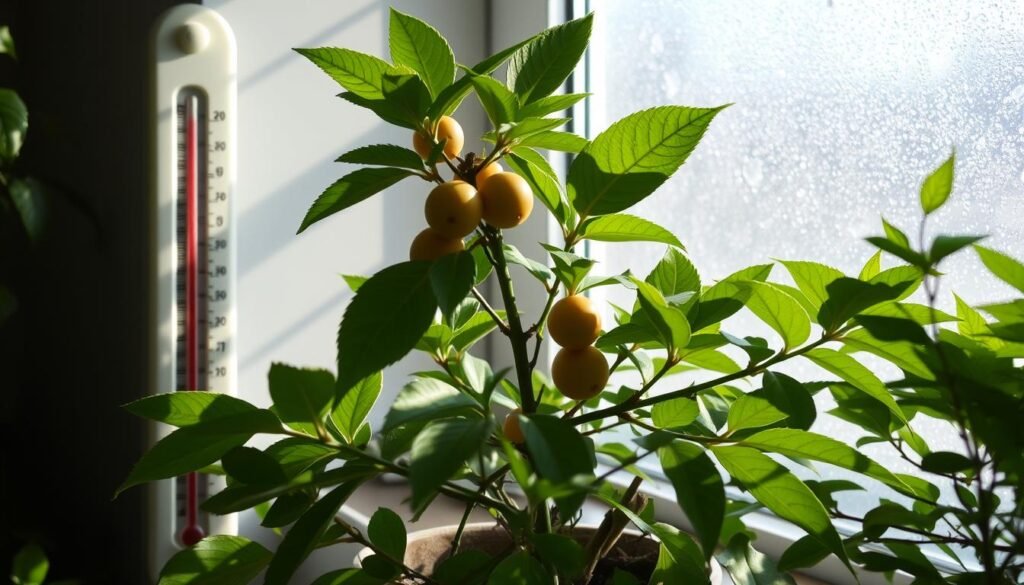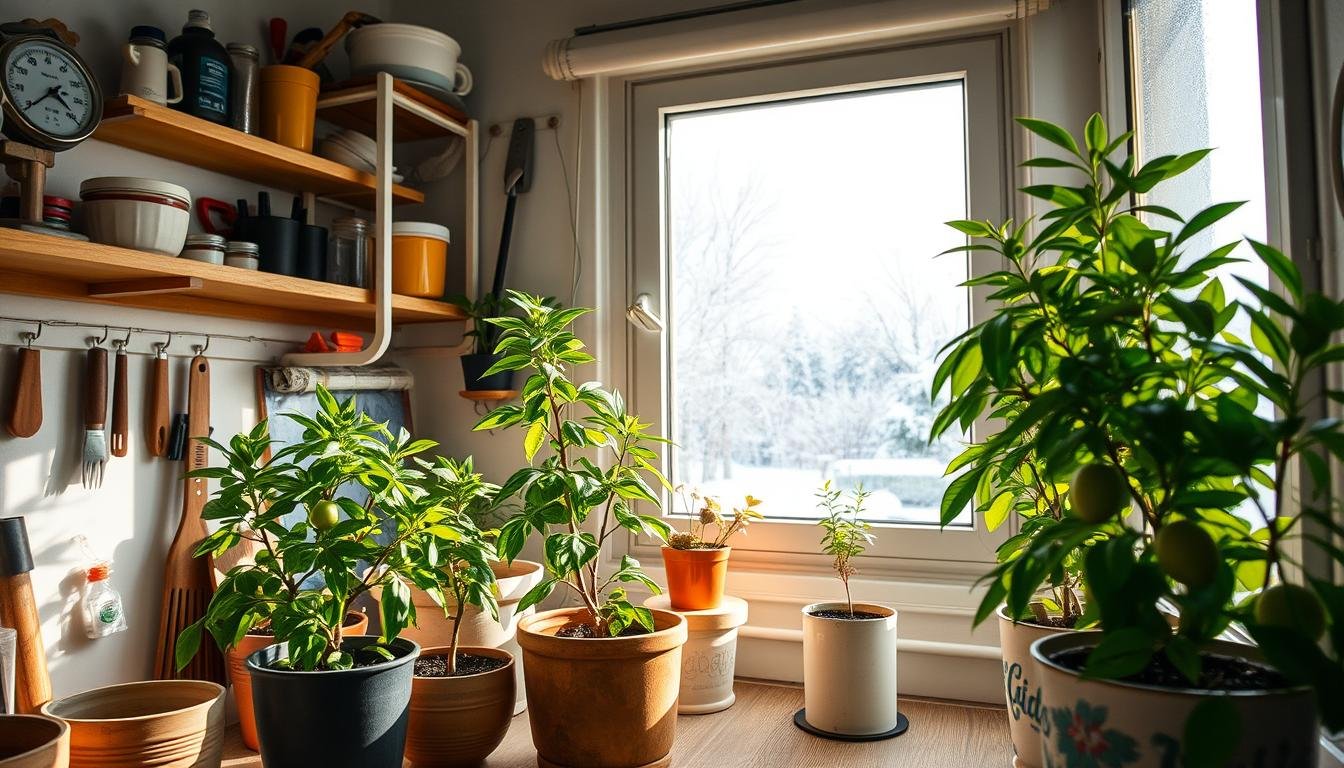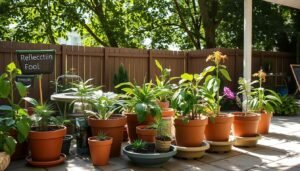Want to know how to grow amla indoors in cold weather? Then this guide will help you learn about growing amla indoors, especially in the cold. Amla, or Indian gooseberry, is a tough plant with lots of health benefits. It’s full of vitamin C.
We’ll talk about the best conditions for growing amla, the right varieties for indoors, and how to care for it. This will help you grow this amazing tree in your home.
Key Takeaways
- Amla needs 4-6 hours of sunlight a day to grow well.
- The soil should be slightly alkaline, well-draining, and rich in organic matter.
- It takes 3-6 weeks for amla seeds to germinate.
- Humidity between 40%-65% is best for growth.
- Young amla plants need water every two weeks in summer.
- Amla trees start bearing fruit in 3-4 years.
- With good care, amla can produce up to 60 pounds of fruit.
Table of Contents
Introduction to Amla and its Benefits
Amla, or Indian gooseberry, is a key part of Ayurvedic medicine. It tastes refreshing and is full of nutrients. It has lots of vitamin C, almost as much as three oranges or sixteen bananas.
Amla also has minerals like calcium, phosphorus, iron, and carotene. It has vitamin B complex too. This makes it very nutritious.
Amla is not just for eating. It boosts the immune system, aids digestion, and improves eyesight. It can also help the heart by lowering blood fat and pressure.
Using amla can also help with hair and skin care. Its extract stops skin collagen breakdown and helps hair grow. Drinking amla juice, made with water, lemon, honey, pepper, and salt, boosts its health benefits.
Amla Plant Characteristics and Growing Conditions
The amla plant is great for indoor growing. It can grow up to 18 meters tall outside. But, with pruning, it fits well indoors too.
This plant loves warm weather, best between 46 to 48 degrees Celsius. It grows well and produces fruit in these conditions. It’s also okay with a little drought once it’s settled.
The amla prefers soil that drains well, like sandy or loamy. Good drainage stops waterlogging, which slows growth. It needs lots of sunlight to grow well, so place it where it gets plenty of sun.
Knowing how to care for the amla plant helps with indoor gardening. Meeting its needs ensures it grows well and produces lots of fruit.
Choosing the Right Amla Variety for Indoor Growing
Choosing the right amla variety is key for growing this amazing plant indoors. Each variety has its own growth traits and uses in cooking. Knowing these differences helps your indoor amla garden grow well and taste great.
The Banarasi variety is special because its fruits are big, weighing 45-50 grams. They are light yellow and have six segments. This makes them look good and be useful in cooking, making them a top choice for indoor growing.
The Francis variety is also great. It’s tough and grows a lot, perfect for small spaces. It’s great for getting lots of fruit from a little area.
Chaikaya is another good choice. It has fruits of different sizes and is used in many dishes. Knowing about these varieties can really help your indoor growing. Picking varieties that do well in containers is important, especially because they need light and nutrients.
How to Grow Amla Indoors in Cold Weather

Growing amla indoors in cold weather has its challenges. But, knowing how to care for amla plants indoors can help. Let’s look at how to grow these plants well.
Preparing Amla Seeds for Planting
Starting with good seeds is key. Amla seeds usually sprout in 3-6 weeks. But, temperature and soil moisture can change this time.
To help seeds sprout, I soak them in water for 24 hours. This makes the seed coat softer and helps them grow.
Optimal Pot and Soil Selection
Choosing the right pot and soil is important. I use a mix that drains well, with organic matter, perlite, and sand. This mix helps roots breathe and prevents rot.
I also pick a pot with holes for water to drain. A pot that’s at least 12 inches wide is best for roots to grow.
Sunlight Requirements for Amla Growth
Amla plants love bright, indirect light. They need about 6 hours of light each day. A sunny window is perfect, but I watch for too much light.
In winter, I use grow lamps to keep them healthy. Good light is key for their growth and fruit.
Watering and Moisture Needs of Amla
My indoor amla plant needs the right care, especially when it comes to watering. A healthy amla plant can handle a lot, but the right amla watering schedule is key. Knowing how much water it needs helps avoid problems from too little or too much water.
Establishing a Watering Schedule
Creating a good amla watering schedule helps it grow strong. I watch the soil moisture and adjust as needed. Here are some amla watering tips I use:
- Water deeply once a week to encourage root growth.
- Reduce frequency during winter months, as the plant takes in less water during dormancy.
- Always check the top inch of soil; if it feels dry, it’s time to water again.
- Use pots with drainage holes to avoid water stagnation.
Signs of Overwatering and Underwatering
Spotting wrong watering signs early can save my amla plant. Too much water causes root rot, while too little makes leaves wilt. Here’s how to spot these issues:
| Condition | Signs |
|---|---|
| Overwatering | Yellowing leaves, soggy soil, and a sour smell from the pot. |
| Underwatering | Wilting leaves, dry soil, and leaf drop. |
By watching for these signs, I keep my amla plant happy and healthy. With the right care, it will grow well and even produce fruit.
Temperature Requirements for Indoor Amla Plants

Amla plants need certain temperatures to grow well and produce fruit. Knowing the right temperature is key for indoor growers. The best temperature is between 46-48 degrees Celsius, which keeps them healthy.
Creating a good indoor climate is important for amla plants. They don’t like cold, so keep them away from frost. Indoors, I use heating lamps and adjust air flow to keep the temperature right.
Amla plants can handle some cold, but young ones are more sensitive. I watch the temperature closely in winter. If it gets too cold, I use a heat source to protect them.
Having a stable indoor space is crucial for amla plants. I aim for a warm environment and avoid sudden temperature drops that can harm them.
Indoor Amla Plant Care Throughout the Seasons
To keep my indoor amla plants healthy, I change how I care for them with the seasons. Winter is especially important because of the cold and less sunlight. I adjust my care to help them thrive all year.
Winter Care Tips for Amla Houseplants
In winter, I change how I care for my amla plants. This is because it’s colder and sunnier. Here are some key tips for winter:
- Keep the temperature between 60-75°F for best growth.
- Water less often, letting the soil dry a bit before watering again. This stops root rot.
- Put plants near a window that gets a lot of sunlight.
- Use a grow light if there’s not enough natural light.
- Watch for pests because dry air from heaters can attract them.
Pruning and Maintenance Practices
Pruning is key to my amla plants’ health. It makes them look good and grow more. Here’s how I prune:
- Take off dead or yellow leaves to help new ones grow.
- Cut long branches to keep the plant bushy and air flowing.
- Prune after the last frost to protect young shoots.
- Use sharp, clean tools to avoid stressing the plant.
Amla Cold Tolerance and Protection
Amla, also known as Indian Gooseberry, faces challenges in cold weather. Its amla cold tolerance is not high. So, we must take steps to keep it safe from frost and freezing.
To protect my indoor amla plants, I keep them warm. I place them in spots away from cold air. This helps a lot.
When it gets very cold, I cover my plants with cloths or frost blankets. This helps a lot in keeping them healthy. I also watch the temperature and humidity around them. I try to keep it like tropical weather.
To sum up, here’s a simple table of what I do to protect my plants:
| Action | Description |
|---|---|
| Placement | Keep amla plants in a warm, sunny spot indoors. |
| Covering | Use fabric covers on cold nights to ward off frost. |
| Monitoring | Regularly check temperature and humidity levels. |
| Watering | Reduce watering during winter to prevent root rot. |
By following these steps, my amla plants stay healthy all winter. They’re ready to grow strong when it gets warmer.
Container Gardening for Amla: Best Practices
Amla container gardening is great for growing indoors. It lets you enjoy the fruit no matter the weather. To grow well, follow some key tips. Here’s how to make your amla gardening a success.
Choosing the Right Container Size
The right container size is key for a healthy amla tree. Amla trees need room to grow their roots. A 10-inch container is good for young plants.
As the tree gets bigger, move it to a larger container. This helps it keep growing.
Ensuring Proper Drainage
Good drainage stops waterlogging and root rot. Amla likes well-draining soil. Make sure your container has holes for water to drain.
Use a mix of potting soil and organic matter. This helps water drain better. It’s important for keeping the tree healthy.
| Container Size | Age of Amla Plant | Recommended Soil Volume |
|---|---|---|
| 10 inches | Seedling (0-4 months) | 2-3 gallons |
| 12 inches | Young Tree (4 months – 3 years) | 5-7 gallons |
| 16 inches | Mature Tree (3+ years) | 10-15 gallons |
Following these tips will help your amla container garden thrive. You’ll have a healthy indoor garden with Amla fruit.
Harvesting Amla: What to Expect
Harvesting amla is a rewarding experience for indoor gardeners. Knowing when and how to pick the fruits is key. It makes enjoying this unique fruit even better.
Timeframe for Fruit Production
Amla trees start producing fruit 3-5 years after planting. The best time to harvest amla is from mid to late June. This is when the fruit is at its peak flavor.
With proper care, amla trees can keep producing fruit for 65 to 70 years.
How to Harvest Amla Fruits
Harvesting amla correctly is important to keep the fruit fresh. Here are some tips:
- Harvest on a dry day to avoid moisture problems.
- Twist the fruit gently to remove it from the tree without damaging the branches.
- Collect the fruits in a basket without stacking them to prevent bruising.
- Check the fruits for freshness and quality. Throw away any that are spoiled.
Following these tips can improve your amla fruit production. It ensures you get to enjoy the health benefits of this nutritious fruit. Harvesting amla with care has been a positive experience for me.
Conclusion
Growing amla indoors in cold weather is possible with the right care. This guide helps me understand what my amla needs. It needs sunlight, water, good soil, and the right temperature to thrive.
Amla trees are tough and good for my health. They have more vitamin C than oranges. This vitamin boosts my immune system and keeps me healthy.
With hard work, I can enjoy the benefits of growing amla at home. The fruiting season is special. Mature trees give lots of fruits full of antioxidants and minerals.
By growing amla, I help the environment and my community. It’s not just about growing plants. It’s about taking care of myself and others.
I’m excited to harvest my own amla fruits. It shows my dedication to sustainable farming. It helps with food security and protects nature.




